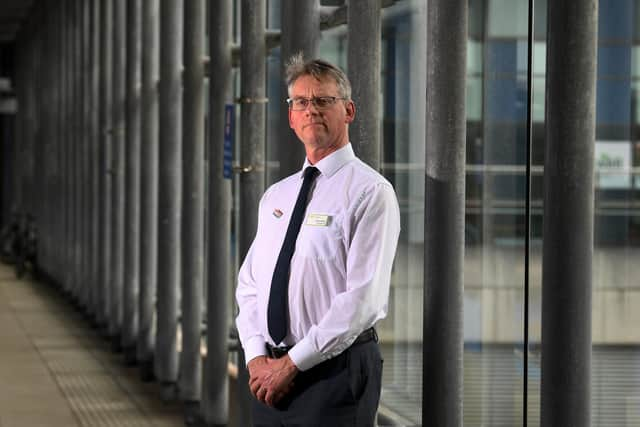Leeds hospital chief tells of how he thinks 'every day' about those stuck on waiting lists as he unveils raft of measures to tackle the backlog
and live on Freeview channel 276
Julian Hartley, chief executive of the trust - one of the largest and busiest in the UK - apologised to all those whose care had been interrupted by the “extraordinarily hard” past two years and said he feels a “heavy duty to do right by those patients”.
He sat down with the Yorkshire Evening Post to discuss major work going on behind the scenes to help drive down the numbers of those waiting for elective treatment; projects which aim to boost the hospitals’ treatment capacity, improve access to get more people in and work with other partners within the city’s healthcare system to use “every ounce of spare capacity”.
Advertisement
Hide AdAdvertisement
Hide AdIt comes as the latest NHS England figures show the waiting list for hospital treatment in Leeds has risen to 79,435 patients, as of the end of February - 3,777 more than were waiting in December.


The scale of the issue was also laid bare in a recent report prepared for the city’s Clinical Commissioning Group (CCG)’s governing body, which met on Wednesday, and described “close to 100 per cent” bed occupancy levels at LTHT, waits of “more than 12 hours” in A&E and inpatients having to stay in areas “not usually used for overnight care”.
These are among the many factors which have impacted surgical activity and fed into the growing backlog since it originated when hospitals were initially told to stand down all non-urgent care at the start of the pandemic, to make way for the influx of Covid patients.
Further waves have seen similar suspensions of elective procedures, and, combined also with staff isolations, wards taken over by Covid patients and strict infection prevention and control measures - which take up vital time and space - the hospital’s level of activity has been forced to reduce.
Advertisement
Hide AdAdvertisement
Hide AdMr Hartley said: “Everyone has been incredible in managing the surge of patients coming into hospital with Covid. But of course, on top of that, we have had lots of patients rightly coming to us for urgent care. We have had a very busy A&E, been very busy on the wards.
“And at the same time, we are trying to do more elective work - planned care, people coming in for the operations they need.
“That adds a sort of third level of challenge, to make sure that we are creating space and staff to see all those patients who have missed out on their treatment. And consequently the waiting lists - as they are throughout the NHS - are significant.”
He said: “I think about it every day. I read letters from patients that I get and our teams are in regular communication with patients that have waited a long time.
Advertisement
Hide AdAdvertisement
Hide Ad“I feel a great responsibility and a very heavy duty to do right by those patients. And I want to reassure them that I’m thinking about you - as are our executive team and board at Leeds Teaching Hospitals - every day of every week.”
Mr Hartley said the trust was actually making good headway into the backlog towards the back end of last year, before “Omicron knocked us for six”.
And with the number of Covid patients in hospital on the rise, currently at around 130, the pressures on the hospital remain high.
Mr Hartley said: “I don’t think we are over it yet. [But] I think our priority has really shifted to how we can get more patients through our operating theatres and so on while managing the ongoing impact of Omicron and new variants.”
Advertisement
Hide AdAdvertisement
Hide AdRecovery is already underway, with more operations being carried out in February (2,337) than in January (2,212) but hospital bosses have come up with a series of measures to try and return pre-pandemic levels, and beyond.
These include:
*A new ‘appointments hub’, which will allow patients to book and amend appointments, to make the process “more convenient and user-friendly”.
*More operations at weekends in a number of specialities, and Mr Hartley expressed his gratitude to the staff who had signed up for more weekend shifts to help tackle the backlog.
*More day surgery, so patients who are suitable don’t need to stay in overnight.
Advertisement
Hide AdAdvertisement
Hide Ad*Increasing the operating capacity at both Leeds General Infirmary and St James’s Hospital with the addition of three more theatres.
*Additional MRI and CT facilities being brought in - a key part of elective procedures.
*Funding has been approved for two ‘elective care hubs’ at Wharfedale Hospital and Chapel Allerton Hospital, where extra theatres will be built to carry out planned procedures away from the busy main hospital sites in Leeds.
*Leeds Children’s Hospital is also holding ‘super Saturdays’ where hundreds of extra appointments take place and new technologies are trialled, including using virtual reality to distract children during medical procedures.
Advertisement
Hide AdAdvertisement
Hide Ad*More face-to face appointments as well as virtual appointments.
*Working with partners to support people in their own homes or in the community.
*Sharing patients between hospital trusts across West Yorkshire, and matching better with each hospital's speciality, which Mr Hartley
